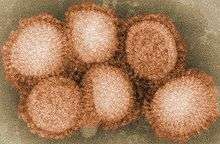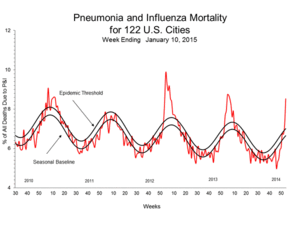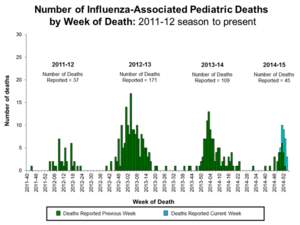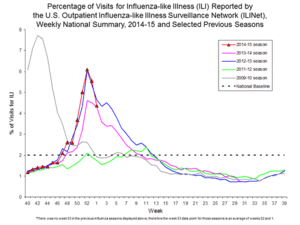Flu season
| Influenza (Flu) |
|---|
 |
| Types |
| Vaccines |
| Treatment |
| Pandemics |
| Outbreaks |
| See also |
Flu season is an annually recurring time period characterized by the prevalence of outbreaks of influenza (flu). The season occurs during the cold half of the year in each hemisphere. Influenza activity can sometimes be predicted and even tracked geographically. While the beginning of major flu activity in each season varies by location, in any specific location these minor epidemics usually take about 3 weeks to peak and another 3 weeks to significantly diminish immediately.[1]
The 2012–13 flu season was particularly harsh in the United States, where the majority of states were reporting high rates of influenza-like illness.[2][3][4] The Centers for Disease Control reported that the available flu vaccine was 60% effective.[4][5] It further recommended that all persons over age 6 months get the vaccine.[4][5]
Cause
Three virus families, Influenzavirus A, B, and C are the main infective agents that cause influenza. During periods of cooler temperature, influenza cases increase roughly tenfold or more. Despite higher incidence of manifestations of the flu during the season, the viruses are actually transmitted throughout populations all year round.
Each annual flu season is normally associated with a major influenzavirus subtype. The associated subtype changes each year, due to development of immunological resistance to a previous year's strain (through exposure and vaccinations), and mutational changes in previously dormant viruses strains.
The exact mechanism behind the seasonal nature of influenza outbreaks is unclear. Some proposed explanations are:
- People are indoors more often during the winter, they are in close contact more often, and this promotes transmission from person to person.
- A seasonal decline in the amount of ultraviolet radiation may reduce the likelihood of the virus being damaged or killed by direct radiation damage or indirect effects (i. e. ozone concentration) increasing the probability of infection.
- Cold temperatures lead to drier air, which may dehydrate mucous membranes, preventing the body from effectively defending against respiratory virus infections.[6][7][8]
- Viruses are preserved in colder temperatures due to slower decomposition, so they linger longer on exposed surfaces (doorknobs, countertops, etc.).
- In nations where children do not go to school in the summer, there is a more pronounced beginning to flu season, coinciding with the start of public school. It is thought that the day care environment is perfect for the spread of illness.
- Vitamin D production from Ultraviolet-B in the skin changes with the seasons and affects the immune system.[9][10][11]
Research in guinea pigs has shown that the aerosol transmission of the virus is enhanced when the air is cold and dry.[6] The dependence on aridity appears to be due to degradation of the virus particles in moist air, while the dependence on cold appears to be due to infected hosts shedding the virus for a longer period of time. The researchers did not find that the cold impaired the immune response of the guinea pigs to the virus.
Research done by National Institute of Child Health and Human Development (NICHD) in 2008 found that the influenza virus has a "butter-like coating". The coating melts when it enters the respiratory tract. In the winter, the coating becomes a hardened shell; therefore, it can survive in the cold weather similar to a spore. In the summer, the coating melts before the virus reaches the respiratory tract.[12]
Timing

In the United States, the flu season is considered October through May.[13] It usually peaks in February.[14] In Australia, the flu season is considered May to October. It usually peaks in August.[15]
Flu seasons also exist in the tropics and subtropics, but are usually less sharply defined. In Hong Kong, which has a humid subtropical climate, the flu season runs from December to March, in the winter and early spring.[16][17]
Flu vaccinations
Flu vaccinations have been used to diminish the effects of the flu season; pneumonia vaccinations additionally diminishes the effects and complications of flu season. Since the Northern and Southern Hemisphere have winter at different times of the year, there are actually two flu seasons each year. Therefore, the World Health Organization (assisted by the National Influenza Centers) makes two vaccine formulations every year; one for the Northern, and one for the Southern Hemisphere.
According to the U.S. Department of Health, a growing number of large companies provide their employees with seasonal flu shots, either at a small cost to the employee or as a free service.
The annually updated trivalent influenza vaccine consists of hemagglutinin (HA) surface glycoprotein components from influenza H3N2, H1N1, and B influenza viruses.[18] The dominant strain in January 2006 was H3N2. Measured resistance to the standard antiviral drugs amantadine and rimantadine in H3N2 has increased from 1% in 1994 to 12% in 2003 to 91% in 2005.[19][20]
Health conditions likely to cause complications

Medical conditions that compromise the immune system increase the risks from flu.
Diabetes
Millions of people have diabetes. When blood sugars are not well controlled, diabetics can quickly develop a wide range of complications. Diabetes results in elevated blood sugars in the body, and this environment allows viruses and bacteria to thrive.
If blood sugars are poorly controlled, a mild flu can quickly turn severe, leading to hospitalization and even death. Uncontrolled blood sugars suppresses the immune systems and generally lead to more severe cases of the common cold or influenza. Thus, it has been recommended that diabetics are vaccinated against flu, before the start of the flu season.[21][22]
Asthma/COPD
It is recommended that asthmatics and COPD patients be vaccinated against flu before the flu season. People with asthma can develop life-threatening complications from influenza and the common cold viruses. Some of these complications include pneumonias, acute bronchitis, and acute respiratory distress syndrome.[23]
Each year flu related complications in the USA affect close to 100,000 asthmatics, and millions more are seen in the emergency room because of severe shortness of breath. It is recommended that asthmatics are vaccinated between October and November, before the peak of the flu season. Flu vaccine works by boosting the body's immune system and takes about 2 weeks to become effective.[24]
Cancer
People with cancer usually have a suppressed immune system. Moreover, many cancer patients undergo radiation therapy and potent immunosuppressive medications, which further suppresses the body's ability to fight off infections. Everyone with cancer is highly susceptible and is at risk for complications from flu. People with cancer or a history of cancer should receive the seasonal flu shot. Flu vaccination is also strict for lung cancer patients, as cancer leads to complications of pneumonia and bronchitis. People with cancer should not receive the nasal spray vaccine. The flu shot is made up of inactivated (killed) viruses, and the nasal spray vaccines are made up of live viruses. The flu shot is safer for those with a weakened immune system. Those who have received cancer treatment such as chemotherapy and/or radiation therapy within the last month, or have a blood or lymphatic form of cancer should call their doctor immediately if they suspect they may have flu.[25]
HIV/AIDS
Individuals who acquire the human immune deficiency virus (HIV) are very prone to a variety of infections. HIV has a tremendous capacity to destroy the body's immune system and this makes one prone to not only viral infections but also bacterial, fungal, and protozoa disorders. People with HIV are at an increased risk of serious flu-related complications. Many reports have shown that individuals with HIV can develop serious pneumonias which need hospitalization and aggressive antibiotic therapy. Moreover, people with HIV have a longer flu season and are at a high risk of death. Vaccination with the flu shot has been shown to boost the immune system and protect against the seasonal flu in some patients with HIV; individuals who have HIV should only get vaccinated with the inactivated influenza vaccine. Any HIV patient who has been exposed to other people with influenza should see a physician to determine if there is a need for anti viral medications.[26]
Cost

The cost of a flu season in lives lost, medical expenses and economic impact can be severe.
- "In the United States of America, for example, recent estimates put the cost of influenza epidemics to the economy at US$ 71-167 billion per year."[27]
A recent study[28] estimated that in the United States, annual influenza epidemics result in approximately 600,000 life-years lost, 3 million hospitalized days, and 30 million outpatient visits, resulting in medical costs of $10 billion annually. According to this study, lost earnings due to illness and loss of life amounted to over $15 billion annually and the total economic burden of annual influenza epidemics amounts to over $80 billion. Also, in the US the flu season usually accounts for 200,000 hospitalizations and 41,000 deaths.
Because the mortality rate of the H1N1 "swine flu" is lower than common flu strains, this number was actually lower in 2009. According to an article in Clinical Infectious Diseases, published in 2011, the estimated health burden of 2009 Pandemic Influenza A (H1N1), between April 2009 to April 2010, was "approximately 60.8 million cases (range: 43.3–89.3 million), 274,304 hospitalizations (195,086–402,719), and 12,469 deaths (8,868–18,306)" "in the United States due to pH1N1."[29][30]
See also
- Influenza
- Influenza vaccine
- Bird flu
- Human flu
- Swine flu
- Horse flu
- Dog flu
- Freshers' flu
- 2012–13 flu season
- 2013–14 flu season
- 2014–15 flu season
- 2015-16 flu season
- 2016-17 flu season
Sources and notes
- ↑ National Institute of Allergy and Infectious Diseases (NIAID) Factsheet
- ↑ Szabo, Liz; Vergano, Dan; Weise, Elizabeth (11 January 2013). "Flu widespread in 47 states". USA Today. McLean, VA: Gannett. ISSN 0734-7456. Retrieved 11 January 2013.
- ↑ Szabo, Liz (11 January 2013). "Questions and Answers: Flu season hits U.S.". USA Today. McLean, VA: Gannett. ISSN 0734-7456. Retrieved 11 January 2013.
- 1 2 3 "As the flu spreads across the country, Boston declares an emergency". Consumer Reports. 10 January 2013. Retrieved 10 January 2013.
- 1 2 "Early Estimates of Seasonal Influenza Vaccine Effectiveness — United States, January 2013" (PDF). cdc.gov. 11 January 2013. Retrieved 11 January 2013.
- 1 2 Lowen, AC; Mubareka, S; Steel, J; Palese, P (October 2007). "Influenza virus transmission is dependent on relative humidity and temperature" (PDF). PLoS Pathogens. 3 (10): e151. doi:10.1371/journal.ppat.0030151. PMC 2034399
 . PMID 17953482.
. PMID 17953482. - ↑ Shaman J, Kohn M (March 2009). "Absolute humidity modulates influenza survival, transmission, and seasonality". Proc. Natl. Acad. Sci. U.S.A. 106 (9): 3243–8. doi:10.1073/pnas.0806852106. PMC 2651255
 . PMID 19204283.
. PMID 19204283. - ↑ Shaman J, Pitzer VE, Viboud C, Grenfell BT, Lipsitch M (February 2010). Ferguson, Neil M., ed. "Absolute humidity and the seasonal onset of influenza in the continental United States". PLoS Biol. 8 (2): e1000316. doi:10.1371/journal.pbio.1000316. PMC 2826374
 . PMID 20186267.
. PMID 20186267. - ↑ Cannell, JJ; Vieth R; Umhau J; Holick M; Grant W; Madronich S; Garland C; Giovannucci E (2006). "Epidemic influenza and vitamin D". Epidemiol Infect. 134 (6): 1129–40. doi:10.1017/S0950268806007175. PMC 2870528
 . PMID 16959053.
. PMID 16959053. - ↑ Cannel, JJ; Zasloff M; Garland CF; Scragg R; Giovannucci E (2008). "On the epidemiology of influenza". Virol J. 5 (29): 29. doi:10.1186/1743-422X-5-29. PMC 2279112
 . PMID 18298852.
. PMID 18298852. - ↑ Adit, G; Mansbach J; Camargo C (2009). "Association Between Serum 25-Hydroxyvitamin D Level and Upper Respiratory Tract Infection in the Third National Health and Nutrition Examination Survey". Arch Intern Med. 169 (4): 384–90. doi:10.1001/archinternmed.2008.560. PMC 3447082
 . PMID 19237723.
. PMID 19237723. - ↑ Polozov, IV; Bezrukov L; Gawrisch K; Zimmerberg J (2008). "Progressive ordering with decreasing temperature of the phospholipids of influenza virus". Nat Chem Biol. 4 (4): 248–55. doi:10.1038/nchembio.77. PMID 18311130.
- ↑ CDC Questions and Answers 2010-01-27, Retrieved 2010-08-10.
- ↑ CDC: The Flu Season
- ↑ Australian Department of Health and Ageing. Australian influenza report 2011 Retrieved 2012-06-03
- ↑ Florence H.Y. Yap; Pak-Leung Ho; et al. (June 2004). "Excess hospital admissions for pneumonia, chronic obstructive pulmonary disease, and heart failure during influenza seasons in Hong Kong". Journal of Medical Virology. 73 (4): 617–623. doi:10.1002/jmv.20135.
- ↑ Chit-Ming Wong; King-Pan Chan; Anthony Johnson Hedley; J. S. Malik Peiris (December 2004). "Influenza-associated mortality in Hong Kong". Clinical Infectious Diseases. 39 (11): 1611–1617. doi:10.1086/425315.
- ↑ Daum LT, Shaw MW, Klimov AI, Canas LC, Macias EA, Niemeyer D, Chambers JP, Renthal R, Shrestha SK, Acharya RP, Huzdar SP, Rimal N, Myint KS, Gould P (August 2005). "Influenza A (H3N2) outbreak, Nepal". Emerging Infect. Dis. 11 (10): 1186–91. doi:10.3201/eid1108.050302. PMC 3320503
 . PMID 16102305.
. PMID 16102305. - ↑ Bird Flu: Threat or Menace? Why avian sniffles need not ruffle our feathers... too much Ronald Bailey October 19, 2005
- ↑ Lawrence K. Altman (January 15, 2006). "This Season's Flu Virus Is Resistant to 2 Standard Drugs". The New York Times. Retrieved 30 October 2006.
- ↑ flu.gov: Diabetes and the Flu
- ↑ CDC brochure on flu vaccination for diabetics
- ↑ Flu Season Overview North Carolina Immunization portal. Retrieved 2010-02-09
- ↑ Centers for Disease Control and Prevention. "HIV/AIDS and the Flu" 2010-02-09.
- ↑ Centers for Disease Control and Prevention. "Cancer and the Flu" Retrieved 2012-11-05
- ↑ Flu Season 2005-2006: Questions & Answers MedicineNet. Retrieved 2010-02-09
- ↑ WHO Influenza Overview http://www.who.int/mediacentre/factsheets/2003/fs211/en/
- ↑ Molinari, Ortega-Sanchez, Messonnier, Thompson, Wortley, Weintraub, Bridges The annual impact of seasonal influenza in the US: Measuring disease burden and costs doi:10.1016/j.vaccine.2007.03.046 PMID 17544181
- ↑ Sundar S. Shrestha; David L. Swerdlow; Rebekah H. Borse; Vimalanand S. Prabhu; Lyn Finelli; Charisma Y. Atkins; Kwame Owus-Edusei; Beth Bell; Paul S. Mead; Matthew Biggerstaff; Lynnette Brammer; Heidi Davidson; Daniel Jernigan; Michael A. Jhung; Laurie A. Kamimoto; Toby L. Merlin; Mackenzie Nowell; Stephen C. Redd; Carrie Reed; Anne Schuchat; Martin I. Meltzer (2011). "Estimating the Burden of 2009 Pandemic Influenza A (H1N1) in the United States (April 2009–April 2010)". Clinical Infectious Diseases. 52 (suppl 1): S75–S82. doi:10.1093/cid/ciq012.
- ↑ "Flu Season Continues; Severity Indicators Rise". Centers for Disease Control and Prevention, National Center for Immunization and Respiratory Diseases (NCIRD). January 17, 2014. Retrieved 24 January 2014.
Further reading
- CDC U.S. influenza season summary with weekly updates — Contains about a dozen charts and graphs with extensive text
External links
- Health-EU portal EU response to influenza
- European Commission - Public Health EU coordination on Pandemic (H1N1) 2009